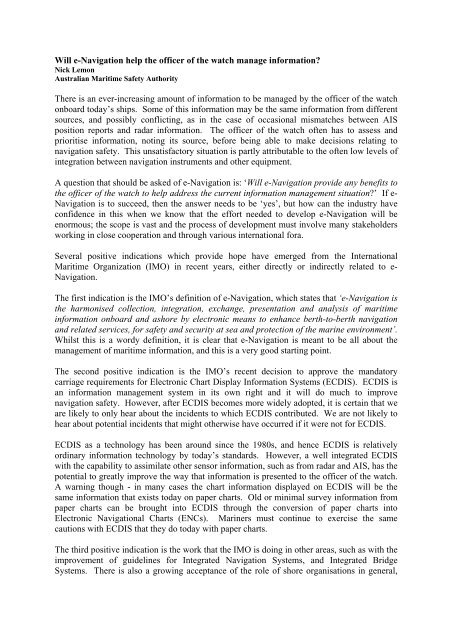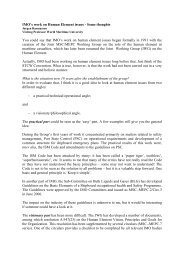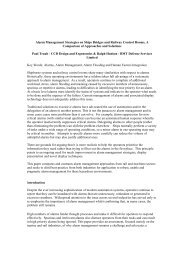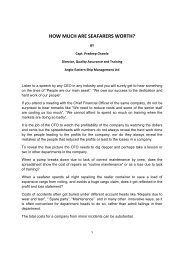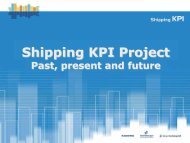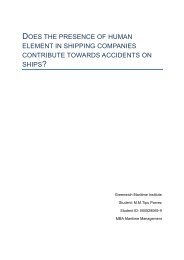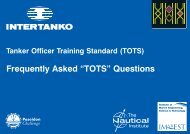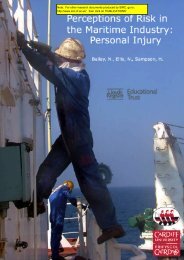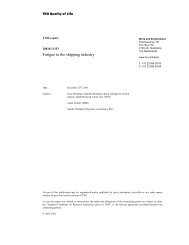Download PDF - Alert!
Download PDF - Alert!
Download PDF - Alert!
Create successful ePaper yourself
Turn your PDF publications into a flip-book with our unique Google optimized e-Paper software.
Will e-Navigation help the officer of the watch manage information?<br />
Nick Lemon<br />
Australian Maritime Safety Authority<br />
There is an ever-increasing amount of information to be managed by the officer of the watch<br />
onboard today’s ships. Some of this information may be the same information from different<br />
sources, and possibly conflicting, as in the case of occasional mismatches between AIS<br />
position reports and radar information. The officer of the watch often has to assess and<br />
prioritise information, noting its source, before being able to make decisions relating to<br />
navigation safety. This unsatisfactory situation is partly attributable to the often low levels of<br />
integration between navigation instruments and other equipment.<br />
A question that should be asked of e-Navigation is: ‘Will e-Navigation provide any benefits to<br />
the officer of the watch to help address the current information management situation?’ If e-<br />
Navigation is to succeed, then the answer needs to be ‘yes’, but how can the industry have<br />
confidence in this when we know that the effort needed to develop e-Navigation will be<br />
enormous; the scope is vast and the process of development must involve many stakeholders<br />
working in close cooperation and through various international fora.<br />
Several positive indications which provide hope have emerged from the International<br />
Maritime Organization (IMO) in recent years, either directly or indirectly related to e-<br />
Navigation.<br />
The first indication is the IMO’s definition of e-Navigation, which states that ‘e-Navigation is<br />
the harmonised collection, integration, exchange, presentation and analysis of maritime<br />
information onboard and ashore by electronic means to enhance berth-to-berth navigation<br />
and related services, for safety and security at sea and protection of the marine environment’.<br />
Whilst this is a wordy definition, it is clear that e-Navigation is meant to be all about the<br />
management of maritime information, and this is a very good starting point.<br />
The second positive indication is the IMO’s recent decision to approve the mandatory<br />
carriage requirements for Electronic Chart Display Information Systems (ECDIS). ECDIS is<br />
an information management system in its own right and it will do much to improve<br />
navigation safety. However, after ECDIS becomes more widely adopted, it is certain that we<br />
are likely to only hear about the incidents to which ECDIS contributed. We are not likely to<br />
hear about potential incidents that might otherwise have occurred if it were not for ECDIS.<br />
ECDIS as a technology has been around since the 1980s, and hence ECDIS is relatively<br />
ordinary information technology by today’s standards. However, a well integrated ECDIS<br />
with the capability to assimilate other sensor information, such as from radar and AIS, has the<br />
potential to greatly improve the way that information is presented to the officer of the watch.<br />
A warning though - in many cases the chart information displayed on ECDIS will be the<br />
same information that exists today on paper charts. Old or minimal survey information from<br />
paper charts can be brought into ECDIS through the conversion of paper charts into<br />
Electronic Navigational Charts (ENCs). Mariners must continue to exercise the same<br />
cautions with ECDIS that they do today with paper charts.<br />
The third positive indication is the work that the IMO is doing in other areas, such as with the<br />
improvement of guidelines for Integrated Navigation Systems, and Integrated Bridge<br />
Systems. There is also a growing acceptance of the role of shore organisations in general,
and Vessel Traffic Services (VTS) in particular, in contributing to the safe berth to berth<br />
movement of vessels and their cargoes around the globe. Some of the most impressive<br />
maritime information system developments are taking place in the realm of VTS. These<br />
involve the collection, management and display of multiple sensor inputs in a coherent, user<br />
friendly presentation.<br />
In VTS and other shore-based organisations there are some significant developments taking<br />
place in relation to ‘maritime domain awareness’. This approach is building on the<br />
integration of sensor information with underlying intelligence, including AIS information<br />
from terrestrial receivers, long range identification and tracking information and additional<br />
ship and waterway related information, and feeding the results into various analysis tools.<br />
Trials are also being carried out on the inclusion of AIS information from satellite borne<br />
receivers, and the level of maritime domain awareness that can result from all of this is<br />
remarkable.<br />
In summary the indicators surrounding the development of e-Navigation are pointing toward<br />
a hope that e-Navigation will provide many benefits to the officer of the watch which will<br />
result from the improved management of maritime information at sea and ashore. If an old<br />
information technology such as ECDIS can bring about definite improvements in navigation<br />
information management, then we should expect that new generation information system<br />
technology, being applied through a phased introduction of e-Navigation, will significantly<br />
improve the officer of the watch’s ability to make consistently good navigation safety<br />
decisions.<br />
Paramount now, is that the international community get behind this initiative and that all<br />
those working on the development of e-Navigation in the various international fora do all<br />
they can to ensure that e-Navigation will be ‘compelling’ for ship owners. In essence, e-<br />
Navigation should be something that the industry needs and wants.


